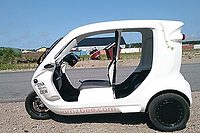
While the innovations at the East Liberty Plant (ELP) focused largely on the weld and assembly departments, each supporting department was asked to look for ways to increase productivity and flexibility. In the paint department, the engineering team identified downtime caused by plugged tips on sealer guns as an area for improvement. Its top equipment evaluation criteria were safety/ergonomics, quality, delivery and cost effectiveness.

On-line tests were successful. Within five months, ELP’s sealing robots were converted to the PrecisionFlo system with PrecisionSwirl applicators on each robot.

Quality, Appearance Improved
“The most obvious improvement is quality,” said Heath. “Our old process featured a low-pressure system that laid the bead on the seam. In certain areas, the bead would not stay on the seam, or it would slide on vertical surfaces. We had to pay special attention to these seams in the brushing area.
“Our new system lets us adjust the applicator’s rotational speed, standoff distance and flow rate for greater control and for better penetration on irregularly shaped parts,” Heath continued. “It also provides higher pressures so the bead is injected into the seam, creating a more resilient seal. Subsequently, we’ve reduced the opportunity for water leaks while increasing consistency on the bead profile. This reduces the amount of brush work by associates down the line.”
The electric orbital applicator produces a wide variety of closed circular-loop bead patterns, material thicknesses and pattern widths. The swirl pattern can be applied to horizontal or vertical surfaces, which makes the PrecisionSwirl equipment an effective applicator to seal the many seams on the body of a car.
“General appearance has improved,” Heath adds. “The swirl bead is flat, which blends into the frame and makes it more appealing.”
Naderer explained that they elected to reduce the speed of the robots performing the job. “This cut wear on the robots and the entire system, lowering maintenance and service costs,” he said. “The PrecisionFlo features independent gun controls for different processes, flow rates and pressures, allowing a second gun to be mounted on the robots that seal the wheel wells.”

Additional Sealing at Same Cycle Time
The 2001 Civic required additional sealing compared to the 2000 model. The increased production capability of the PrecisionSwirl allowed Honda to do the additional work without increasing cycle time. “Ultimately, we were able to address the requirements of the new Civic model without increasing cycle time or adding manpower, robots and equipment,” said Heath.
“Furthermore, it was relatively easy to install the equipment without disrupting production because the system components were modular,” says Naderer. “And, the ease of programming the Swirl pattern significantly reduced robot programming time. This, coupled with the modular equipment, allowed the installation of two or four units on a non-production weekend. Most of the installation and programming were performed by our own engineering team and line associates.”
“It’s a very easy system to monitor and maintain,” says Heath. “In addition, our production downtime due to plugged tips has been virtually eliminated, brushing has been reduced significantly in most areas, material savings have been recognized and the work area is cleaner.”
“As with any new installation of this size, we had some production issues that had to be addressed during installation and startup,” says Naderer. “Graco responded promptly to our needs and worked closely with us to make this system meet our requirements. From an application standpoint, it does exactly what we have programmed it to do.”
Naderer and Heath credit the support they received within the plant to accomplish the project in such a short timeframe.




